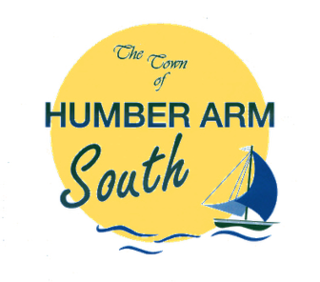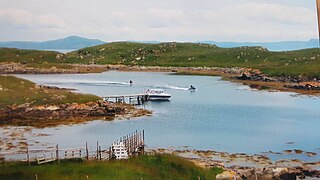Badger is a town in north-central Newfoundland, Newfoundland and Labrador, Canada on the Exploits River. It supplied pulp and paper for the mills in Grand Falls for many years and was famous for its large spring log drives. The town is located in the interior of the island, twenty miles west of Grand Falls in Division No. 6. Badger was incorporated as a Town on September 30, 1963.

Stephenville is a town in Newfoundland and Labrador, Canada, on the west coast of the island of Newfoundland.

Grand Bank or 'Grand Banc' as the first French settlers pronounced it, is a small rural town in the Canadian province of Newfoundland and Labrador, with a population of 2,580. It is located on the southern tip or "toe" of the Burin Peninsula, 360 km from the province's capital of St. John's.

Glovers Harbour, formerly known as Thimble Tickle(s), is an unincorporated community and harbour in the Canadian province of Newfoundland and Labrador. It is located in Notre Dame Bay on the northern coast of the island of Newfoundland. As a local service district, it is led by an elected committee that is responsible for the delivery of certain essential services. It is delineated as a designated place for statistical purposes.
The Burin Peninsula is a peninsula located on the south coast of the island of Newfoundland in the province of Newfoundland and Labrador. Marystown is the largest population centre on the peninsula.

English Harbour East is a town in the Canadian province of Newfoundland and Labrador. It is located on the northeast side of Fortune Bay. Settled first by the Mi’kmaq of Newfoundland which used land on the “Neck” of the Harbour, they were joined in the early 1800s, by the English Dodge family and by Irishman Thomas Hynes Sr. European fishermen were first brought to the small community by English merchant family of Newman and Co. based in Harbour Breton, the firm of merchant John Gorman, and the Jersey firm of Nicholle and Co. The town had a population of 117 in the Canada 2021 Census.

Humber Arm South is a town in the Canadian province of Newfoundland and Labrador. The town had a population of 1,599 in the Canada 2016 Census. The Town's Post Office is located in the section of the town referred to as Benoit's Cove. Humber Arm South is located in the Bay of Islands, and is in the Humber-Bay of Islands electoral district.

St. Bernard's-Jacques Fontaine is a town in the Canadian province of Newfoundland and Labrador. The town had a population of 433 in the Canada 2016 Census, a drop from 470 in 2011.
Ship Harbour is a community in Newfoundland and Labrador, Canada located on the eastern shore of Placentia Bay.
Fortune Harbour or Fortune Harbor is a designated place in the Canadian province of Newfoundland and Labrador.

Iona was a small community in Placentia Bay, Newfoundland and Labrador made up of small islands that used to be inhabited. The islands were once called The Ram's or Ram's Islands.

Woods Island is an island in the Canadian province of Newfoundland and Labrador. It contains an abandoned town with the same name.

Little Placentia Sound is an abandoned town in Newfoundland and Labrador that had a peak population of 47 in 1901. It is named after the body of water (sound) that encompasses the former community located within Placentia Bay on the Avalon Peninsula in the Canadian province of Newfoundland and Labrador. There was once a lead mine called Silver Cliff Mine located within the town.
Prowseton, formerly known as Civilly's Cove, Sibley's Cove, or Civil East Cove, is an abandoned town in Newfoundland and Labrador that had a population of 28 in 1966. Its name was changed in 1915 to avoid confusion with the nearby town of Sibley's Cove in Trinity Bay and to honour Judge D.W. Prowse. The town was mostly abandoned by the mid 1960s but had a few residents up until the 1990s.

Rose au Rue is an abandoned whaling town in Newfoundland and Labrador, Canada that had a small population of 11 in 1891.
Pays Cove is an abandoned town in Newfoundland and Labrador, Canada that had a peak population of 11 in 1935.
Ryle's Barrisway is an abandoned town in Newfoundland and Labrador, Canada that had a small population which was first recorded in 1898.
New Harbour is an abandoned town located within Fortune Bay in Newfoundland and Labrador, Canada that had a peak population of 24 in 1945. It is not to be confused with New Harbour, Trinity Bay and New Harbour on the south-west coast of Newfoundland.
Jemmy's Cove is a tiny abandoned town located near New Harbour, Fortune Bay in Newfoundland and Labrador, Canada that had a peak population of 6 in 1911.
Cape Roger Harbour is a tiny abandoned town located near St. Joseph's, Placentia Bay in Newfoundland and Labrador, Canada that had a tiny population of 4 in 1845. Despite only being sparsely inhabited, the harbour has been used since the early 19th century for the fishery, particularly that of the herring and salmon fishery.










